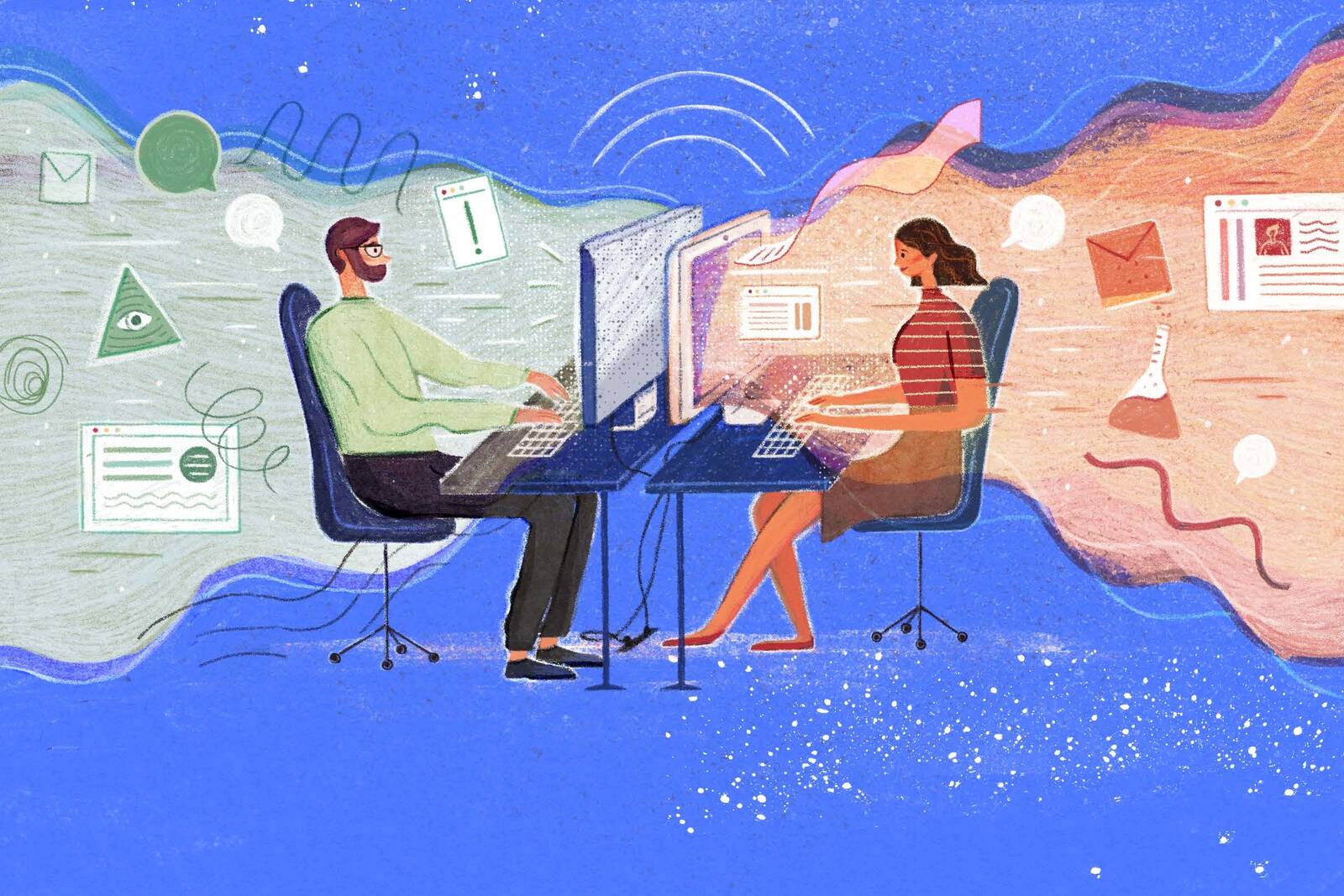Organizations Politics & Elections Aug 3, 2020
Why Are Social Media Platforms Still So Bad at Combating Misinformation?
Facebook, Twitter, and users themselves have few incentives to distinguish fact from fiction.
In 2016, the Russian Internet Agency purchased ads and created content on Facebook in an act of information warfare aimed at disrupting the U.S. presidential election. Facebook estimates that 126 million users viewed Russian-created content in what The Mueller Report described as a “social media campaign designed to provoke and amplify political and social discord in the United States.”
In the months leading up to this November’s election, Hatim Rahman, an assistant professor of management and organizations at the Kellogg School, is closely watching Facebook and other social-media platforms like Twitter, YouTube, and WhatsApp to see how they handle misinformation this time around. And the trends he sees concern him.
“Thanks to increasingly powerful algorithms, the speed and scale at which misinformation can spread is unprecedented,” says Rahman.
Rahman points to three reasons why misinformation on social media is such an intractable challenge—and what this might mean going forward.
Shrouded Sources
One shortcoming of the major social-media platforms is that it is often difficult for users to determine the sources of the information that makes it into their feeds.
Most social-media users would agree that it is important to know who is generating misinformation—but so far it has been difficult for users, regulators, or even the platforms themselves to pinpoint where messages are coming from, much less why they are being generated. Lone individuals in their basements? A cadre of foreign trolls, as in 2016? Or networks of organizations?
Part of the problem is that most platforms don’t require posters to identify themselves before spreading information. Nor, for that matter, do the platforms verify whether the information being shared is accurate. Knowing this, individuals and organizations often design propaganda with the intention of it spreading across platforms before its origins are determined.
Research on the major sources of misinformation is ongoing, Rahman says, but he observes that it is becoming increasingly clear that political misinformation is often seeded and spread through surprisingly coordinated, well-financed campaigns that might prefer to stay under the radar.
“It’s usually very well shrouded, especially because coordinated campaigns might want to give the impression that their message is grassroots,” Rahman says. “Or if there are prominent funders involved, they don’t want those ties to be revealed.”
Of course, if social-media platforms wanted to, they could require more stringent indentity-verification procedures, thus ensuring that sources are in fact who they say they are. Google has done this for its advertisers, for instance. And Twitter already has a mechanism in place to verify users—its blue-checkmark badges—but Twitter reserves this function for what it describes as “accounts of public interest.” That leaves the vast majority of Twitter accounts unverified.
The Wrong Incentives
Why are social networks so reluctant to take action on misinformation and propaganda?
“If you look at Facebook and Twitter — the platforms themselves — they knew to a certain extent that these things were occurring,” Rahman explains. “It’s just that they have different motivations” than many users and regulators.
“Some people don’t really care about the source or veracity of the information. As long as it aligns with their political view, they will spread it.”
— Hatim Rahman
What Rahman means is that ignoring misinformation serves these sites’ interests to an extent. After all, shareholders reap rewards when user numbers grow and viral content spreads, and research has shown that divisive content tends to get higher engagement. This set of conditions provides platforms with a perverse incentive to look the other way at fake, violent, or racist content.
“Viral content pays,” Rahman says. “It attracts more advertisement, more eyeballs, more time and attention to the platforms. But we’ve seen serious trade-offs to maximizing those type of metrics for platforms.” For instance, one study finds that, of the top 50 most popular Facebook posts that mentioned voting by mail, an essential part of our election infrastructure, 44 percent contained misinformation.
Willing Spreaders
With platforms largely focused on growing user rates, the responsibility for discerning the veracity of posts largely falls on users. Rahman sees this as unfair, especially given that users are at an information disadvantage. Not only that, the only real leverage users have to demand change is to vote with their feet by deleting their accounts and leaving the platform.
Leaving this responsibility up to users is also unlikely to be effective, in part given users’ predilection toward believing what they want to believe, and in part because of an even more disturbing phenomenon: users simply not caring whether something is true.
In this regard, Rahman sees a troubling trend: although users are becoming more sophisticated about judging whether online content is accurate, some users are also becoming more comfortable in willingly spreading misinformation when they agree with the underlying message it is trying to convey. They are also less likely to verify sources or fact-check posts that support their worldview.
“What sometimes gets missed is that some people don’t really care about the source or veracity of the information,” Rahman says. “As long as it aligns with their political view, they will spread it.”
According to Rahman, this behavior represents a shift in how we think about misinformation spreading from the last presidential election. In 2016, many believed that most users shared information that they thought was true and were only vaguely aware of online trolls, “fake news,” and hackers. Today, people are more aware of online deception. But many users still perpetuate it.
Glimmers of Hope
So if platforms won’t act to mitigate misinformation—and individuals are inclined to spread it—what’s to be done? It’s not entirely clear, Rahman says.
While regulating complicated, fast-developing, global technologies can be difficult for lawmakers, there remains a role for policy that balances accountability and consumer protection with free-speech concerns.
“The role of regulation is to incentivize and hold organizations accountable for being more proactive, rather than telling the platforms what to do,” Rahman says.
Still, Rahman sees a glimmer of hope that the platforms themselves might be coming around to addressing the problems with misinformation.
Given the storm of COVID-19, the surge of Black Lives Matter protests in the wake of George Floyd’s death, and the lead-up to November’s election, it feels like the platforms’ tolerance for misinformation may be shifting.
For instance, Twitter added “Get the Facts” labels to potentially misleading information, including President Trump’s tweets about California’s plans for vote-by-mail. It also placed a warning on one of his tweets following the Minneapolis protests for glorifying violence. Facebook is currently facing an unprecedented push—including a boycott from major advertisers—to take similar steps.
Platforms could also reconfigure their algorithms to prioritize information that is accurate, from sources that can be readily identified.
“AI can be viewed as a tool that’s neither good nor bad. Depending largely on how they use it, it reveals the values and intent of an organization,” Rahman says.
With so much at stake within a short time frame, it’s “all hands on deck” in what he calls a “push and pull” moment where all stakeholders must play a role.
“We need researchers for their rigorous interdisciplinary problem-solving approaches. We need community organizations for their ability to voice concerns from underrepresented groups. We need users for their lived experiences and governments for their regulatory powers. We need all these brought to together in ways that are necessary, but that platforms have thus far resisted.”



